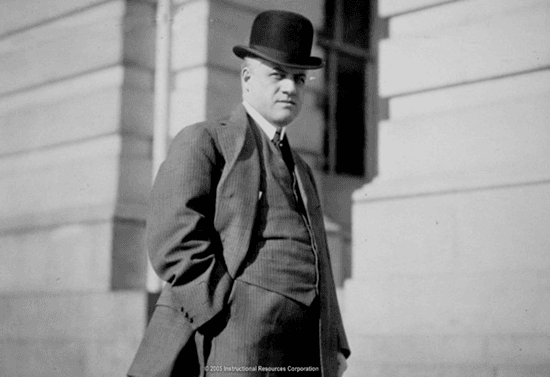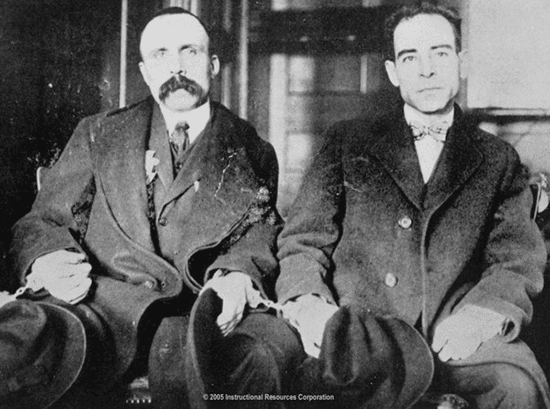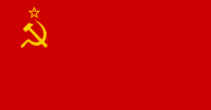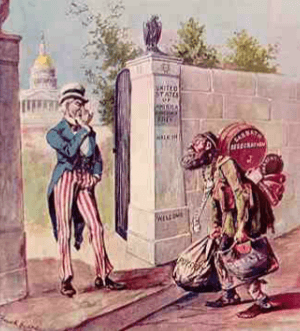Learn
Hysteria
Hysteria in the 1920s
The transition back to normalcy, in the wake of The Great War (World War I), did not happen with ease.
Americans eager to keep their jobs, went on strike to protect their high wages and stable factory work.
The fear of communism enveloped the country as the government arrested suspected subversives (persons who intended to overthrow the government) to protect the nation from the influence of political radicals.
Immigrants and other minorities continued to struggle for acceptance as white Americans viewed them with suspicion and scorn. With all of the accomplishments and prosperity of the 1920s for some Americans, for others, it was a time of great pain and turmoil as they fought for acceptance in America.

Alexander Mitchell Palmer was President Wilson's attorney general. He was a leading advocate in the belief that Bolshevik supporters were behind American labor unrest.

Nicola Sacco and Bartolomeo Vanzetti were two Italian immigrants charged with murder and robbery in 1920. During the trial, their anarchist ideas proved to be more destructive than any evidence that they committed the crime.
The Red Scare
Background and Context Review
World War I erupted in Europe in 1914. By the time the United States entered the conflict, much of Europe had been fighting for three years.
The Russians suffered great hardship during the war and had become increasingly attracted to a revolutionary group called the Bolsheviks. Led by Lenin and Trotsky, the Bolsheviks offered promises to pull Russia out of the unpopular war.
Thus, in 1917, the Bolsheviks gained control over Russia, and as promised, pulled the nation out of WWI. The party quickly worked to transform Russia into a soviet state under a new name: Union of Soviet Socialist Republics (U.S.S.R.).
After Russia withdrew from the war in 1917, the United States continued fighting until the war ended in 1918.
Though peace had been achieved in Europe, life at home in the U.S. was not peaceful. Between 1919 and 1920 the U.S. experienced several labor strikes by union workers. The striking laborers hoped to keep their jobs and high wages that they had earned during the war.
The American people, many of whom were suspicious of strikes, viewed the strikers as radical revolutionaries. They assumed the strikers aimed to create a communist government in the United States, much like the newly created U.S.S.R.
Adding to the hysteria in 1919, a series of bombs were sent through the mail. The post office, in fact, intercepted 40 bombs addressed to well-known Americans such as John D. Rockefeller and J.P. Morgan. Americans began to associate the strikers and the terrorist activities believing they were acting under orders from Soviet leaders.
Red Scare
A fear of communism quickly swept the nation in a hysteria known as the "Red Scare." For nearly two years, Americans were so consumed by their fear of communism that they tolerated extreme actions by the U.S. government to eradicate communism from the nation.
"Red Scare" derived its name for the red color of the Bolshevik flag that was later adopted by the Soviet Union.

The Government Responds
Following a bomb explosion at Attorney General Mitchell Palmer's home, the government stepped into action.
Laws, such as the Sedition Act, that had been passed during World War I were used to arrest persons suspected of being subversives (persons who intended to overthrow the government). The Sedition Act passed in 1918 prohibited anyone from speaking or acting out against the government or war.
Read The Sedition Act of 1918 to learn details about the act.
Palmer Raids
To enforce the Sedition Act, Attorney General Mitchell Palmer created a new division of the Justice Department, called the Intelligence Divisions (later known as the FBI), to gather information on suspected radicals.
J. Edgar Hoover was in charge of gathering information and leading raids on subversives. These raids were referred to collectively as the "Palmer Raids".
Between 1919 and 1920, several thousand suspected persons were arrested, many of them without warrants. Labor union members, criminals, recent immigrants, radical intellectuals, communists, and anarchists were all targeted. Of that group, nearly 250 people were sent back to the Soviet Union.
Effects of the Red Scare
By the end of 1920, the Red Scare hysteria had begun to subside, in part because Palmer's predictions of future terrorist acts never came to fruition.
The extreme actions taken by the Justice Department conducting searches without warrants and denying legal representation to suspects were increasingly viewed as government abuses of power. Americans had had enough.
Though the raids and investigations had stopped by the end of 1920, the effects of the Red Scare were felt for years to come.
- Labor unions continued to face resistance to their activities. The anti-union open shop movement started to gain momentum.
- Immigrants, who were once suspected of subversive activities during the Red Scare, continued to face hostility in its aftermath.
Immigration Restrictions

Anti-immigrant hostility continued throughout the rest of the 1920s.
Americans became increasingly fearful of immigrants' "foreign ways" and beliefs and a number of petitions were made to further limit immigration to the United States.
Read Intolerance to learn more about the restrictions placed on immigrants.
In Summary
- The Red Scare was marked by an intense fear of communism.
- The U.S. government responded by organizing a series of "Palmer Raids" to arrest, jail and/or deport subversives.
- The government relied on war-time legislation, such as the Sedition Act, violating basic constitutional rights.
- Anti-immigrant hysteria was heightened. Immigration laws were passed to limit European and Asian immigration.
- The Ku Klux Klan experienced a resurgence in membership